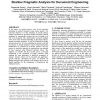Free Online Productivity Tools
i2Speak
i2Symbol
i2OCR
iTex2Img
iWeb2Print
iWeb2Shot
i2Type
iPdf2Split
iPdf2Merge
i2Bopomofo
i2Arabic
i2Style
i2Image
i2PDF
iLatex2Rtf
Sci2ools
DOCENG
2009
ACM
2009
ACM
From rhetorical structures to document structure: shallow pragmatic analysis for document engineering
In this paper, we extend previous work on the automatic structuring of medical documents using content analysis. Our long-term objective is to take advantage of specific rhetoric markers encountered in specialized medical documents (clinical guidelines) to automatically structure free text according to its role in the document. This should enable to generate multiple views of the same document depending on the target audience, generate document summaries, as well as facilitating knowledge extraction from text. We have established in previous work that the structure of clinical guidelines could be refined through the identification of a limited set of deontic operators. We now propose to extend this approach by analyzing the text delimited by these operators using Rhetorical Structure Theory. The emphasis on causality and time in RST proves a powerful complement to the recognition of deontic structures while retaining the same philosophy of high-level recognition of sentence structure,...
| Added | 28 May 2010 |
| Updated | 28 May 2010 |
| Type | Conference |
| Year | 2009 |
| Where | DOCENG |
| Authors | Gersende Georg, Hugo Hernault, Marc Cavazza, Helmut Prendinger, Mitsuru Ishizuka |
Comments (0)

